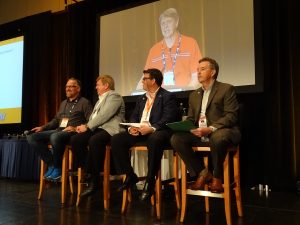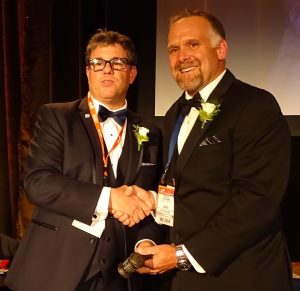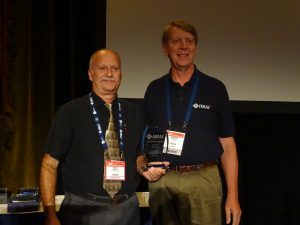
Change is in the air
September 10, 2017 | By Michael Power
Attendance ramped up compared to last year for the 49th-annual conference of the Heating, Refrigeration and Air Conditioning Institute of Canada (HRAI) in Quebec City. Held August 16-18, the event saw changes to the organization that included Bruce Passmore appointed chair while Warren Heeley, HRAI’s president, announced his retirement.
Strengthening regional representation and ensuring money earmarked for climate change projects is spent wisely are among top priorities for Passmore, of Emco Corporation, who described some of his agenda for the upcoming year to members during the Chairs’ Banquet on August 17.
He noted the importance of communication with governments and utilities as well as industry consultation on climate change issues. He also stressed that HRAI will continue investing in online courses, webinars and other educational events.
“There are many regions that could use our support,” said Passmore, while pressing members to encourage their colleagues to volunteer at the organization.
Similar to previous years, the conference kicked off with a year in review presentation that, among other areas, described HRAI’s communications efforts. The organization has gotten a social media consultant and new LinkedIn account, as well as initiating more targeted advertising. It also held its first Day on the Hill in Ottawa, during which HRAI’s board and senior staff met with MPs and senior civil servants. The agenda included climate change, door-to-door sales tactics and raising awareness of the HVAC/R industry.
EDUCATIONAL SESSIONS
HPAC columnist Robert Bean of Indoor Climate Consultants Inc., presented a session called Online, Simple and Free: Thermal Discomfort Risk Assessment Tools for Residential and Small Commercial Buildings. The tools he discussed can predict how uncomfortable people will be in an indoor space. The websites, for example one created by Payette, also allow users to pinpoint where changes can be made in a building to allow compliance with the standard.
“They’re free, they’re online and they’re dead simple to use,” Bean told the audience. “What’s not to like about that?”
Users must fill out input values into the software, for example drywall temperature. “Everybody can do that,” Bean said. “Everybody has an instrument that you can measure the temperature, or you’re going to be able to read it off the thermostat on the wall.”
Other inputs include humidity, air speed, the metabolic rates of the room’s occupants, surface temperatures and so on. Bean also explained how to calculate mean radiant temperature, which describes the relationship of a person in a space to all the surfaces in the room and is a function of the area, distance and the temperature.
As windows are added to a building, the lower the radiant temperature will be and the higher the risk of discomfort, Bean said. As well, since women often wear lighter clothing, they tend to feel colder in rooms than men. Payette’s online tool can account for this and other factors, Bean said.
Knowing this allows for conversations with architects about the risks, he noted, and users can show clients what they will experience in the space.
“What you’re doing is you’re having those discussions upfront with the client rather than on the back end,” Bean said.
An education session that proved popular was entitled IoT Trends Revealed as it Relates to Intelligent Residential & Commercial Buildings, Net Zero Energy, Controls and Cybersecurity. The session, run by Ron Zimmer, president and CEO of Continental Automated Buildings Association (CABA), focused on intelligent buildings research. Zimmer noted that connectivity through the Internet of Things (IoT) is spreading as technology adoption goes up while costs fall. And while there are currently 20 billion connected devices, Zimmer estimated that number will climb to 80 billion by 2025.
“It will impact on every one of us–as consumers, as home owners, in our business, how we shop, how we play, how we drive,” he said.
How big is the market? Lighting represents a low-hanging fruit in this area, Zimmer said. Not many buildings have lighting controls that change the lighting, he added, which represents enormous opportunity.
Meanwhile, sensors now allow people to provide greater value to clients. For instance, heating professionals can differentiate themselves from competitors by using sensors to determine the location of a leakage or when something is failing.
“Sensors are what is going to make the big difference,” Zimmer said. “Sensors are everywhere.”
Whatever the technology, businesses must change with the times. Those that stay the same will be left behind.
Some places, such as Germany and certain jurisdictions in California, are moving towards zero net energy buildings, Zimmer said. It makes sense to shoot for zero net energy for new buildings, he noted, although not necessarily for existing ones.
Plug loads are becoming an enormous energy cost, with users plugging several devices into a single plug, he said. Human behaviour plays a key role in moving towards zero net energy. Zimmer encouraged companies to use incentives as a tool to change behaviour—for example, use the savings from lower energy use to through a party for employees.
“The occupants are key to this whole process,” he said.
PAINT THE INDUSTRY BRIGHT
A town hall meeting on August 8 wrapped up the event with a panel touching on topics that included careers, refrigerants and climate change. To attract new people the industry must spread the word about what the field has to offer, said panel member Bruce Passmore.
“The opportunities aren’t going away quickly. There are great paying jobs,” he said. “It’s up to all of us to paint the industry with a positive start.”
Outgoing chair and fellow panelist Rick Ellul, of Belimo Americas, agreed that reframing the industry for a fresh audience could help attract newcomers. The field now involves more technology—and not just traditional tools—that could appeal to those considering it for a potential career. “That should be more attractive to young people,” he said.
Heeley, the moderator, noted that the industry is sophisticated and becoming more so as time goes on. To interest newcomers, it is important to tell the story of that sophistication and how important they will be to the lives of people in Canada.

Town hall panel from left, Bruce Passmore, Dave Weishuhn, Rick Ellul and Dave McPherson, with moderator Warren Heeley in the background.
“There’s a story to be told and we’re not telling it the right way,” said Heeley. “We’ve got to learn how to tell it the right way because that’s how it to become attractive.”
The town hall moved on to discuss refrigerants, with Heeley noting that the push is to move refrigerants towards lower global warming potential. With that typically comes the issue of flammability, he noted. “These alternatives could bring into play increased safety concerns for technicians and customers,” Healey said. “How will the industry manage this safety concern as these substances become more prevalent?”
Regarding equipment, the U.S. is behind Canada by about two years, said Dave McPherson of Rheem Canada Ltd., chair of the 2017-2018 HRAI Manufacturers Division board of directors, so changes will take place in Canada first. Labeling on equipment will help reduce safety risks, he noted. “But I think one of the most important ways to help reduce the risk of flammability is education and awareness, and baking it into your contractor technical training,” he said. “Ensure it’s on your website and all the ways you touch consumers, your contractors and stakeholders.”
On climate change, the panel looked at how HRAI should position itself as governments move towards greenhouse gas reductions. The industry is evolving and HRAI must keep up, said David Weishuhn, secretary/treasurer and chair, contractors division, also of Blue Flame Heating & Air Conditioning Ltd.
Going forward, the government will not introduce incentives for natural gas and is moving towards banning the installation of natural gas in new homes by 2030. Heat pump incentives, however, are on their way, said Weishuhn.
NEW BEGINNINGS
At the chair’s banquet, Heeley announced plans to retire from the organization next June. While addressing attendees Heeley, who has worked for HRAI for more than 35 years, remarked on the growth that the association had experienced over the years and thanked the audience for a fulfilling career.
“It’s time for a new leader to take HRAI forward,” he said, also noting that he will work with the board in searching for a replacement, a process that will begin in fall, 2017.
Heeley’s career will be celebrated at HRAI’s 50th Anniversary Conference on October 14-16, 2018 in Playa del Carmen, Mexico. www.hrai.ca






